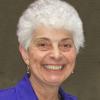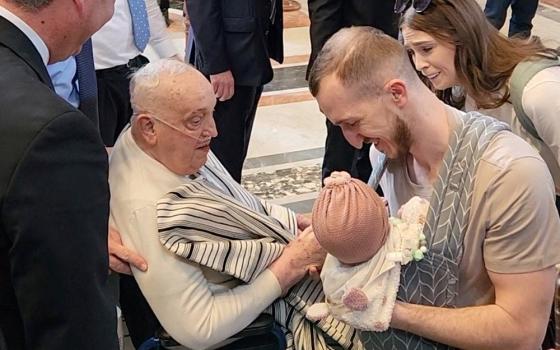About 20 years ago, my students in the TV department of Brooklyn College invited the late Fr. Jim Harvey and Michael Moran as guests on a program on homelessness. Two memories stand out. Jim, who worked with street kids and prisoners, described his experience of spending a week living in Manhattan without money or identification. He begged so he could eat, and he slept in the underground network hidden from the eyes of those on the city streets and in office buildings. When I asked Jim what he learned, he answered: "Hunger really, really hurts."
 Michael, now 69, spoke about working with unemployed individuals. He'd seek job openings and worked the systems until his clients could qualify for an apartment or room of their own. I'll never forget his account of a man who, after years on the streets and in shelters, was finally given a key to his own apartment. He held it as though it were an indescribable treasure as he wept in relief.
Michael, now 69, spoke about working with unemployed individuals. He'd seek job openings and worked the systems until his clients could qualify for an apartment or room of their own. I'll never forget his account of a man who, after years on the streets and in shelters, was finally given a key to his own apartment. He held it as though it were an indescribable treasure as he wept in relief.
These two men, Jim and Michael, were willing to enter the worlds of people who live on the margins in order to experience their sadness. Both worked to bring them to places of comfort and inclusion.
Today, Michael Moran lives half the year in California, the other half in New York. Although much has changed, much has remained the same -- including the fact that we share an Oct. 17 birthday!
Sr. Camille: Michael, please tell us about your early years.
Moran: I was raised in a Brooklyn home of an Irish (by descent) father and an Italian/German (by descent) mother. Mom converted from Lutheranism to Catholicism when she married Dad. I have three brothers and one sister. I am the baby of the family. My family ran a hand laundry service, and, as an infant, a laundry basket was my playpen. I attended Catholic elementary, high school and college, so I was well versed in pre-Vatican II Catholicism. I entered the Franciscan Brothers of Brooklyn at an early age, served as a brother for 25 years and left that community in 1985.
Although you left the Franciscans, you seem to have carried their values with you through a series of professions. Please trace that journey.
I was a teacher, guidance counselor, school psychologist, high school principal, campus minister, administrator in agencies serving homeless persons and people living with HIV/AIDS, and a hospital chaplain. I retired in July 2010 when I was 67.
Your impressive academic record cites four universities that prepared you for each of these important works. Is there anyone who shares your life?
I have a partner with whom I am celebrating 20 years of life together. He is Japanese, a former sushi chef who is now a caregiver. He's a real introvert who balances my off-the-wall extroversion. His calm personality balances my sometimes frenetic activity. We seem to complement one another nicely.
You divide your time between Laguna Beach, Calif., and New York City. What are the magnets that draw you from one to another?
Being bicoastal is a metaphor for my need for action and contemplation. In New York, I involve myself in cultural, social and volunteer opportunities. I love the diversity of this city. In California, I also volunteer, but take significant time to walk the beach and enjoy the beauty of nature.
What is your favorite scripture passage?
Does this passage, Jesus' blueprint of how to care for our neighbor's needs, make a difference in your life?
It means everything. I consider it my vocation -- a blueprint for how I try to live my life.
What is your image of God?
Jesus on the breadline. I draw it from a Catholic Worker lithograph by artist Fritz Eichenberg. I see God as personally connected to my life and the life of the worlds he identifies with the marginalized and rejected.
That poignant, black-and-white painting reminds me that you spent eight years as co-founder and executive director of Long Island's Interfaith Nutrition Network.
There's an interesting story in that connection. When I lived as a volunteer in one of the network's shelters, we had a fire that destroyed the house. No one was hurt. The only thing that survived the fire was a framed picture of this lithograph.
Has your image of God changed over time?
You bet your boots! I used to think of God as ultimately removed from me and the world and making all decisions from a distant venue. Now my God is imminently present in my life. God has no life plan for me other than my happiness. Whatever happens happens. Yet through good times and bad, God is by my side, crying and laughing with me, never leaving my side. I believe every person who lives had God at his/her side.
What about your faith is most meaningful to you?
My prayer life, my growth in spirituality, my shared life of faith with friends and colleagues, and my attitudes toward social justice issues, including war, gun control, capital punishment, immigration. These concerns find expression in what I believe and do.
How do you pray?
I love mornings. Since I retired, I find I get up earlier than when I was employed, because I don't want to miss anything. I take time to ready the daily scripture, use centering prayer and read from spiritual books. I retreat to Weston at least twice a year. I've been concentrating lately on the works of Thomas Merton. My partner and I stayed recently at The Abbey of Gethsemani, where I felt the spirit of Merton come alive, especially in the lived experience of the monks, but also at Merton's grave.
What most influenced your belief system?
Vatican II and that change it has brought in the church, social action, theology, prayer and sacraments. The open windows continue to breathe fresh air into my life.
Where do you seek spiritual nourishment?
The monks of the Weston Priory in Vermont offer a place of peace and refreshment for me. My ashes will be buried there. I love the monks and the way they continue to bring Vatican II values to life. I admire their social justice stance and the fact that they bring their words into action. Years ago, they welcomed a Guatemalan family into sanctuary on their property. They've provided housing for recently released incarcerated men; they welcome homeless people and those living with HIV/AIDS. No one is excluded. These Benedictine monks offer a great, living example of what our church should be.
In New York, I worship in St. Francis Xavier parish. I cherish the great liturgies and preaching by Jesuits who are not afraid of addressing contemporary social issues. Everyone is welcome to a place at the table.
I volunteer in an Episcopal church that serves meals in its sanctuary to 1,200 people each weekday. From the choir loft hangs a banner that reads, "No one shall be an outcast in the Episcopal Church." I pray that one day that banner can hang in every Catholic church.
What activities enrich your retirement?
When I retired two years ago, I chose the following anagram to express the goals of my retirement: VISIT.
- Volunteer. On both coasts, I've been volunteering in soup kitchens, a shelter, hospitals where I bring my skills as a hospital chaplain. My two favorites are serving as a chaplain on a prison/psych unit at Bellevue in New York City and on the memory care unit of the Sister of St. Joseph in Orange County, Calif.
- Intimacy. I've been attempting to deepen my relationships with my partner, family and friends, both old and new.
- Spirituality. I take time each day for scripture, centering prayer and spiritual reading. My spirituality includes caring for my body. I exercise daily and eat healthy foods.
- Intellectual pursuits. I take courses on both coasts, attend conferences and lectures and read spiritual books. I enjoy the writings of Richard Rohr, Margaret Farley, Elizabeth Johnson and Joan Chittister.
- Travel. My partner and I have driven between our homes on both coasts in two and a half round trips so far. We tent, camp, stay with friends or in motels. We take a different route each time. On our recent trip from west to east coast, we attended a National Conference of the Association of Professional Chaplains, where I offered two workshops: "Training Spiritual Care Volunteers" and "How to Establish and Maintain a 'No One Dies Alone' " program, where volunteers accompany dying persons who otherwise would die alone.
Michael, what do you want from the church?
Openness and inclusion. More dialogue between hierarchy and the rest of us. Openness to the ordination of women and same-sex marriage; more preaching on topics of social justice; compassion and justice for immigrants. I am concerned about the move away from Vatican II. I am very dismayed by the conflict between the bishops and the LCWR. I believe the sisters are our contemporary prophets and the best hope for the church. They should never compromise their rich values. What would our church be without their dedication? We should not allow the hierarchy to hijack our church.
What would prevent that?
Greater dialogue on all sides, open ears and hearts. I believe our church is missing out on the great contributions and gifts of laypeople and could benefit from encouraging these treasures. I would ordain women and gay people and highlights the leadership of laypeople.
What causes you joy?
That so many talented, sincere Catholics have not abandoned our church, but hang in there and do what they can to reinvent it.
What gives you hope?
Every year, I attend the Los Angeles Religious Education Congress with at least 30,000 other people, many of whom are young Latinos/Latinas. To be present at the rich liturgies, the marvelous keynote address and workshops, to experience the warm camaraderie -- this is an experience of church I hope for in the wider church community.
Is there something you wish I had asked?
"Why haven't you become Episcopalian?" My roots are too deep in Catholicism. My parents would turn over in their graves and my good friends, Patrick and Mary Ellen, would feel abandoned. I still have hope that things will change in our dear church.
[Mercy Sr. Camille D'Arienzo, broadcaster and author, narrates Stories of Forgiveness, a book about people whose experiences have caused them to consider the possibilities of extending or accepting forgiveness. The audio book is available through the book's website, storiesofforgiveness.com.]
| We can send you an email alert every time Conversations with Sr. Camille is updated. Go to this page and follow directions: Email alert sign-up. If you already receive email alerts from us, click on the "update my profile" button to add Conversations with Sr. Camille to your list. |




